What Parents Need to Know About IEPs
January 29th, 2020 by Global Down Syndrome Foundation
From Down Syndrome WorldTM 2019 Issue 3 of 4
Individualized education programs are detailed learning plans for students K-12 with intellectual and developmental disabilities enrolled in public school. The process of obtaining, developing, and implementing an IEP for your child can seem overwhelming. Knowing what to expect and planning can help streamline the process.
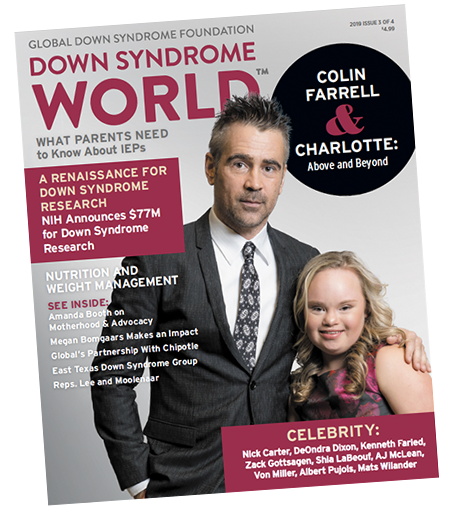 This article was published in the award-winning Down Syndrome World™ magazine. Become a member to read all the articles and get future issues delivered to your door!
This article was published in the award-winning Down Syndrome World™ magazine. Become a member to read all the articles and get future issues delivered to your door! UNDER THE INDIVIDUALS WITH DISABILITIES EDUCATION ACT (IDEA), students with intellectual and developmental disabilities (IDD) enrolled in public school may be eligible to receive free, customized learning plans for their education. Individualized education programs (IEPs) are legally binding plans developed by a team of parents/guardians, teachers, and any other stakeholders that set the course for students with special needs. To obtain an IEP, a child must be enrolled in public school, must be between 3 and 21 years old, have one of 13 intellectual or developmental disabilities, and take eligibility tests administered by the public-school system.
WHAT IS AN IEP?
“An IEP outlines when and where a student will receive instruction, how the student is going to access the curriculum and what curriculum he or she will be accessing … what services will be provided, such as speech-language, occupational, or physical therapy, and who will be providing those services,” says Jennifer Harris, M.S.E., Education Specialist at the Anna and John J. Sie Center for Down Syndrome at Children’s Hospital Colorado, an affiliate of the Global Down Syndrome Foundation.
The Sie Center was the first to embed a full -time education specialist into a Down syndrome medical center in the United States. Harris joined the Sie Center in 2017 and works closely with patients, parents, and teachers to support the education of individuals with Down syndrome. She also works alongside Lina Patel, Ph.D., Director of Psychology at the Sie Center, to help patients navigate the barriers to their education by looking at their unique behavioral profile.
IDEA states that children who are differently-abled should receive a “free, appropriate, public education” in the “least restrictive environment” possible. Children who attend public schools, including charter schools, are eligible for IEPs, but private schools are not required to provide them.
Before a child reaches age 3, families may be eligible through Early Intervention, to receive an individual family service plan (IFSP). This document outlines services young children will receive to support their development prior to entering a public education system — either in pre-school or at home. The team that creates an IFSP includes parents/guardians, professionals such preschool teachers, therapists, any outside advocate or specialist requested by the family, and a service coordinator from the state to help determine needs and implement the plan. When children turn 3, they may transition to an IEP from their IFSP, however you do not need to have an IFSP to apply for an IEP.
EVALUATION TESTS
To start the process of obtaining an IEP, parents/guardians can ask the school district to initiate the evaluation process. The district may also ask the parents for consent to initiate if they have concerns as well. This will begin the assessment process. These assessments involve various tests to determine the child’s specific needs and the most appropriate accommodations for their learning.
Qualification is also based, in part, on whether the condition affects a specific aspect of a child’s learning abilities, such as oral expression, comprehension, or reading, writing, or math skills. Through a variety of tests, they will measure a child’s health, vision, hearing, social and emotional development, motor skills, general intelligence, academic skills, and communication
ability. When the evaluation is finished, the statistical results are presented in a report to all parties involved.
“Results of some of these tests can, potentially, be jarring to parents. No parent wants to read or hear that his or her child scored in a low percentile or significantly below average in certain areas. It is important to understand that this is only a small, fraction of the process,” Harris says. “Testing is fundamental to the process in order to understand the need for services.”
“No one test can be used and no one person can identify a child as having a disability and needing special education, so a variety of assessment tools and strategies must be used to collect relevant functional, developmental, and academic information,” explains Melody Musgrove, Ed.D., Co-Director of the Graduate Center for Early Learning and Associate Professor of Special Education at the University of Mississippi.
There are cases where parents/guardians oppose an IQ test or some standardized testing they feel is not reflective of their child’s ability. While this can hold up the IEP process, it is within a parents’/guardians’ right to not agree with certain testing, and it’s within their right to reject in part or in full the IEP the school presents. There are cases where parents/guardians sue the school to get the services they need, but hopefully legal recourse can be avoided if the family, school, and teachers are all on the same page. There are several avenues that parents and school teams can take to help come to a collaborative middle ground. Many states offer IEP facilitators and options to obtain an educational advocate. These professionals are not attorneys, but they are trained in disability law and can provide an unbiased, fact-based opinion that keeps your child’s educational rights intact.
Although these tests are mandatory, sometimes the methods are flexible and can include verbal and nonverbal formats. Harris encourages families and school teams to look at a variety of cognitive tests to select the most appropriate assessments for the individual child, providing an adequate representation of that child’s skills, capabilities, and needs.
“Your child is still your amazing child, and assessments aren’t going to capture all of the things he or she can do or all the beautiful things that make your kid who he or she is,” she points out. “Look for relative strengths. For example, even if your child is scoring ‘extremely low’ in several categories but maybe just ‘low’ in another area, look at that as a relative strength. Figure out how to draw upon that to support your child’s learning.”
A multidisciplinary team (which simply means professionals from different disciplines, such as special education teachers, psychologists, regular education teachers, and speech language therapists, within the district as well as parents) will determine whether your child meets IDEA’s criteria for special education. If the team deems special education appropriate, your child will be reevaluated every three years.
Reevaluation can take place earlier, if a change in medical condition occurs, your child isn’t making progress in school, or the team suspects that your child no longer requires services.
YOUR IEP MEETING
The First Meeting
Within 30 days of determination of eligibility, the multidisciplinary team is required to develop the IEP in collaboration with the parents and to hold a meeting to review the document.
During the meeting, you’ll review the IEP section by section, including your child’s present level of academic performance, goals for the academic year, how you’ll be informed of progress, special education services the school will provide, accommodations your child will receive, and how and to what degree your child will participate in general education activities.
The school district is responsible for scheduling the meeting, inviting the parents/guardians, and ensuring the proposed time is convenient for them. However, each state has its own timetable for providing notice of a meeting. Parents are not required to attend the meeting but must provide written permission for services to begin. IDEA specifies that your child’s IEP team must consist of a special education teacher, general education teacher, school district representative or administrator who is knowledgeable about general and special education, and an individual who can explain the results of the comprehensive evaluation, such as a school psychologist. Other professionals, such as a speech-language pathologist, may be present.
Be Prepared
At least one week before the meeting, Harris recommends parents request, in writing, a copy of the assessment, the evaluation report, and any other documentation the IEP team will discuss.
Make sure you have time to review the IEP document and write down any questions you have. Questions may include what a word or acronym means or why an accommodation that you believe is important is or isn’t listed. While you prepare, Dr. Musgrove recommends turning to your most valuable resource for information: your child. Ask for his or her thoughts about how things are going at school. Write down any questions you have and your vision for your child’s education. Gather supporting documents, such as medical notes or previous schoolwork that you wish to review with the team. Create a fillable sheet to write down agreed-upon goals and supportive services during the meeting. If you wish, invite a friend, family member, or another individual who knows y our child to attend for support.
WHAT PARENTS NEED TO KNOW
Beware of jargon — if you don’t understand a term, ask the team to explain it in clear, concise language. Ensure the language in the IEP is unambiguous about the services to be provided, when they will begin and end, and your child’s goals.
“If parents don’t agree with the IEP, they need to say, ‘I no longer want this meeting to continue, I need to contact an educational advocate,’ and obtain an educational advocate to walk through next steps,” Harris advises.
Once parents and the school district agree to the IEP and services begin, communication is crucial. If you notice your child struggling in a certain area, notify his or her teacher right away instead of waiting until the next annual IEP review meeting.
IDEA requires an IEP review meeting at least once a year, but parents can request one at any time.
“Parents may find it helpful to have an IEP review meeting at the beginning and end of each academic year, as well as a midyear meeting to get a sense of their child’ s progress,” says Julie
Youssef, D.O., M.P.H., Developmental-Behavioral Pediatrician and Clinical Assistant Professor of Developmental and Behavioral Pediatrics at Stanford University School of Medicine.
“Starting at age 16, the child must be invited,” Dr. Musgrove says.
“I encourage parents to have their children attend IEP meetings much earlier — not necessarily the entire meeting — so they can learn to self-advocate.”
Most importantly, whether you’re new to the IEP process or have experience with it, trust your knowledge and judgment as a parent.
“A lot of parents may feel like they’re ill prepared [to navigate the IEP process], but they’re actually more prepared in ways that they may not immediately recognize,” Harris says. “No one knows their child better than parents … so they need to understand they’re pivotal players and hold information no one else will have. That’s the biggest mistake that parents make — not believing in themselves.”
Like this article? Join Global Down Syndrome Foundation’s Membership program today to receive 4 issues of the quarterly award-winning publication, plus access to 4 seasonal educational Webinar Series, and eligibility to apply for Global’s Employment and Educational Grants.
Register today at downsyndromeworld.org!
Finding Her Voice
January 24th, 2020 by Global Down Syndrome Foundation
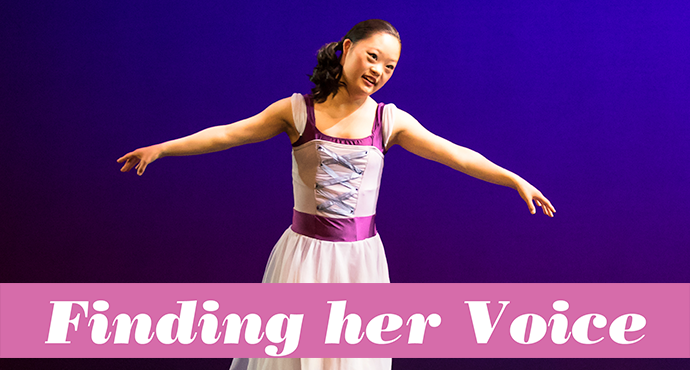
From Down Syndrome WorldTM 2019 Issue 4 of 4
Multi-Talented Performer Meg Ohsada Has Learned That, When It Comes To Communication, Words Aren’t Always Necessary.
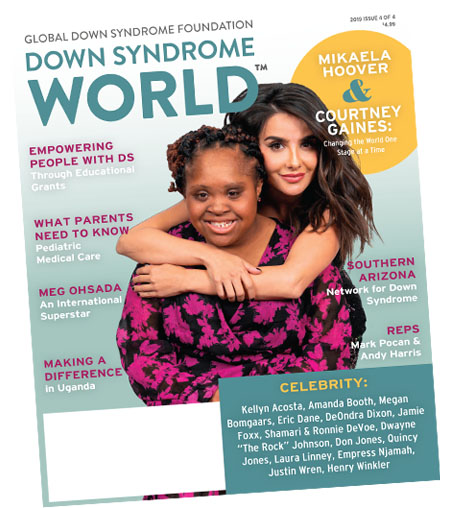 This article was published in the award-winning Down Syndrome World™ magazine. Become a member to read all the articles and get future issues delivered to your door!
This article was published in the award-winning Down Syndrome World™ magazine. Become a member to read all the articles and get future issues delivered to your door! MEG OHSADA, a Canada native who happens to have Down syndrome, has become an international superstar known for her competitive figure skating and dancing with four Special Olympic medals and counting. She is also known for her extraordinary, widely-collected artwork. At just 25-years-old, Meg also has her artwork displayed and purchased at prestigious galleries around the world. And believe it or not, that’s not all she does! She recently took up rhythmic gymnastics and modeling, too.
Born to Japanese parents who immigrated to Canada, Meg is one of three girls. Although Meg is nonverbal, she communicates her powerful and inspirational messages through her passion for sports, fashion, advocacy, and art.
Her accomplishments serve as an inspiration to the Down syndrome community and she recently began modeling to continue her advocacy work for people who are differently-abled.
“Meg is the family’s backbone,” says her mother, Noriko Ohsada. “Her gentle presence has given us love, strength, inspiration, and hope for the future.
A DEDICATED FAMILY
Noriko, who immigrated to Toronto, Canada, from Japan with her husband, Kaoru Ohsada, did not know what Down syndrome was until Meg was born in 1993. In fact, Noriko recalls, she had to learn the word “chromosome” in English when a doctor told her that additional testing was necessary.
Noriko remembers being very scared when she researched the condition. She read that Meg would not live long and would need to be institutionalized. Thankfully, the medically inaccurate information did not deter her and Kaoru’s belief in Meg’s abilities.
From the time Meg was born, her parents noticed she was a happy baby and an energetic, passionate child. Shortly after Meg was born, Noriko and Kaoru had two more daughters: Sari, now 23, and Juli, now 22.
Meg always had difficulties with verbal communication and continued to struggle to talk after undergoing speech therapy.
In 1997, searching for a fresh start and better access to medical care, the family moved from Toronto to Canmore, a small town in Alberta, Canada at the edge of the Canadian Rockies. That’s where Meg’s remarkable artistic abilities began to take shape.
“As my children are close in their age, I always introduced the same activities to all of them,” Noriko says. “Figure skating was the perfect activity for the girls to be athletic and beautiful at the same time. I truly enjoyed watching them.”
“We noticed Meg could remember movements with music very quickly,” Noriko says. “That’s when we realized that performing arts was a way of self-expression.”
LOUDER THAN WORDS
Meg took to figure skating like a natural, impressing her family and her instructors by skating through intricate choreography, remembering every step. At age 8, she joined a local figure skating club and eventually began attending a weekly Special Olympics figure skating program in Calgary, about an hour from Canmore. Meg gets on the ice four to six days a week, for an hour or so a day. Plus, she does yoga, gymnastics, and other physical activities to stay in shape.
She has excelled as a figure skating competitor, earning two gold medals at the 2019 Special Olympics Alberta Winter Games and two silver medals at the 2013 Special Olympics World Games in Pyeongchang, South Korea. In 2015, she competed in the Canada Games, which features athletes of all abilities. She continues to inspire other skaters with and without Down syndrome at her home rink in Canmore.
Meg began her dance career at age 14 and attends four dance classes per week. She is also a rhythmic gymnast, a sport she took up at age 18.
She competed in dance in both the 2015 and 2017 Special Olympics World Games, placing fourth at the 2017 Winter Games in Austria. In 2017, she also performed a ballet solo with Ignite Dance at Banff Centre in Banff, Canada, near her hometown of Canmore.
A MULT-TALENTED ARTIST
Movement isn’t Meg’s only form of expression. At age 21, Meg began a career as an artist, taking classes at the Indefinite Arts Centre in Calgary.
Her artwork has appeared in galleries in Hong Kong, Seoul, and South Korea, and she was the featured artist at a local gallery, artsPlace, in Canmore.
Meg’s favorite piece is an abstract self-portrait of herself dancing.
“She expresses herself through art, and she loves public exhibition opportunities where she can get that recognition from other people,” Noriko says.
Last year, Meg took up modeling as a way to showcase the beauty and talent of people who are differently-abled. “I believe Sari and Juli learned many wonderful lessons from Meg, including her enthusiasm, optimism, and compassion toward others,” Noriko states.
Meg encourages everyone to work hard and find their own voice. Through her multi-faceted art forms, she shares an important message: “Do what you love, and great things can happen.”
Like this article? Join Global Down Syndrome Foundation’s Membership program today to receive 4 issues of the quarterly award-winning publication, plus access to 4 seasonal educational Webinar Series, and eligibility to apply for Global’s Employment and Educational Grants.
Register today at downsyndromeworld.org!
Changing the World One Stage at a Time
January 24th, 2020 by Global Down Syndrome Foundation
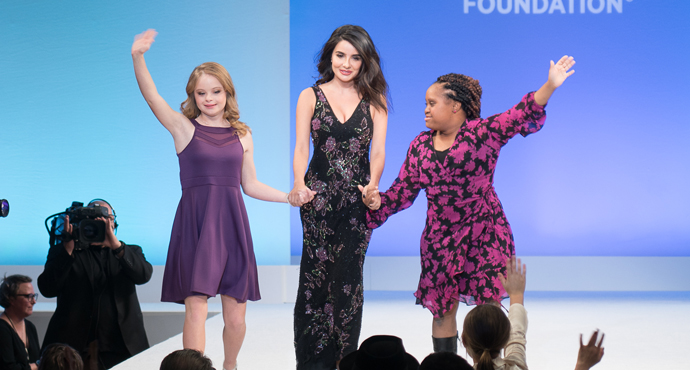
From Down Syndrome WorldTM 2019 Issue 4 of 4
When 16-Year-Old Courtney Gaines Has Her Eyes on the Prize, There’s No Stopping Her. Her Latest Endeavor? Rocking the Runway at Global’s Fashion Show with Model & Actress Mikaela Hoover
 This article was published in the award-winning Down Syndrome World™ magazine. Become a member to read all the articles and get future issues delivered to your door!
This article was published in the award-winning Down Syndrome World™ magazine. Become a member to read all the articles and get future issues delivered to your door! An actress, singer, dancer, and model, 16-year-old Courtney Gaines is no stranger to the spotlight. She is an active member of her community, an Ambassador for a women’s non-profit, and most recently, an entrepreneur. She is determined to show the world that she can do whatever she sets her mind to. What better next stop than to model at the largest fundraiser for Down syndrome in the world?
“The more people see her, the more people love her,” says Courtney’s mother, DeAnna Gaines. Courtney is engaged with many local groups Oklahoma including the Greater Love Missionary Baptist Church, Shining Starz Special Needs Cheer Squad, Down Syndrome Association of Central Oklahoma, and the Air Force JROTC. “Seeing how Courtney’s energy radiates onto everyone around her, we looked for other opportunities for her to shine.”
When DeAnna and Courtney found the Global Down Syndrome Foundation (Global) online they were impressed by the organization’s government work and intrigued by Global’s fashion show. Courtney’s passion for performance and advocacy for inclusion seemed to make her the perfect fit.
“I love to help others and listen to them,” Courtney says. “I want to do good things for others in everything I do.” She is an Ambassador for GirlTrek, the largest national public health non-profit supporting African-American women and girls in the U.S., with a special strategy to connect with women with special needs. Truly a jack of all trades, Courtney also recently started plans for her own business, an online clothing store called CloZet 21c which would raise funds for non-profits.
Courtney’s vibrant personality, loving nature, and happy smile were evident in her audition and she became the first person in Oklahoma to be selected to model in Global’s marquee annual fundraiser, the Be Beautiful Be Yourself Fashion Show. Courtney rocked the runway with Mikaela Hoover, a model, actress, and Instagram influencer who is beautiful inside and out.
Mikaela learned about Global when working on a film in Colombia with her colleague, John C. McGinley, who is a Global board member and international spokesperson. Growing up, Mikaela was very close with her cousin Bobby, who had Down syndrome, and was eager to get more involved in philanthropic work. McGinley told her about Global’s work and Mikaela reached out right away to get involved.
SHINING STARS
Courtney was thrilled to work with a fellow model and actress. “It was so much fun modeling with her! We took selfies and photos backstage too,” Courtney recalls. “She is a great model, she’s so pretty, cool, and very nice.”
As natural performers, Mikaela and Courtney have a lot in common. Mikaela began dancing at the age of 2, and by the time she started school, she was starring in her school’s plays. Mikaela started her acting career in 2006 and is best known for her roles in superhero films including the 2014 box office hit Guardians of the Galaxy and the 2010 superhero dark comedy Super starring Rainn Wilson, Ellen Page, Liv Tyler, Kevin Bacon, and Nathan Fillion. Courtney loves to bring her talents of singing, dancing, and acting to the stage. She was recently in the stage production of Mary Poppins Jr. with Kaleidoscope.
“Courtney was so excited to be on that runway. She knew exactly what she wanted to do and the poses she wanted to strike, and no one was going to stop her,” says Mikaela, who was Courtney’s celebrity escort. “Courtney has so much ambition and carries herself with such grace and independence.”
Both first-timers at Global’s Be Beautiful Be Yourself Fashion Show, Courtney and Mikaela were soaking in every moment. “All of the models had such beautiful energy around them, each one was beaming and shining so bright. It was such an honor to be back there with them,” Mikaela says.
Courtney’s favorite part of the night was blowing her mom a kiss when she was at the top of the stage. “Nothing beats seeing my Courtney up there on stage, dressed to the nines, in the company of Mikaela
and of course our heroes like Jamie Foxx and Quincy Jones,” says DeAnna.
Global’s Be Beautiful Be Yourself Fashion Show raises critical awareness and funds for Down syndrome. This year’s event raised an incredible $2.5 million for Down syndrome research and medical care.
“Global is changing that the narrative surrounding Down syndrome through advocacy and education,” says Mikaela. “Their beauty simply shines from within, and that is definitely something that we need to see more of, not just in the media, but in our world today.”
“All of the models had such beautiful energy around them,” said Mikaela Hoover. “That is definitely something we need to see more of.”
Like this article? Join Global Down Syndrome Foundation’s Membership program today to receive 4 issues of the quarterly award-winning publication, plus access to 4 seasonal educational Webinar Series, and eligibility to apply for Global’s Employment and Educational Grants.
Register today at downsyndromeworld.org!
Born This Way
December 5th, 2019 by Global Down Syndrome Foundation
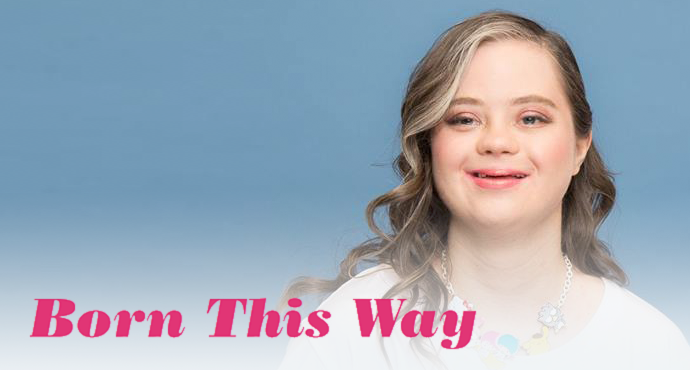
From Down Syndrome WorldTM 2019 Issue 3 of 4
She Stars in a Three-Time Emmy Award-Winning TV Show and Has Two Businesses- and One Big Message for Everyone.
 This article was published in the award-winning Down Syndrome World™ magazine. Become a member to read all the articles and get future issues delivered to your door!
This article was published in the award-winning Down Syndrome World™ magazine. Become a member to read all the articles and get future issues delivered to your door! “DON’T LIMIT ME!” was a battle cry speech that Megan Bomgaars crafted back in 2013 as a high school student in Colorado Springs, Colorado. Fully included herself and part of her state champion cheerleading team, Bomgaars wrote the speech for a school project on inclusive learning. When the video of that speech hit YouTube, Bomgaars suddenly became a viral sensation, which helped catapult her career in television as a key cast member of the three-time Emmy Award-winning TV show, “Born This Way.”
Her perfectly crafted words truly convey Bomgaars’ life philosophy: All people, with or without Down syndrome, can achieve their dreams if they are not limited and have equal opportunity to succeed.
Before her big television break, Bomgaars was invited to numerous speaking engagements and able to spr ead her message of inclusion to audiences all over the world— something she continues to this day. She has presented to nonprofits and corporations in 34 of the 50 states and around the world in countries including Trinidad, Tobago, Spain, Canada, and Mexico. In 2015, Bomgaars represented the Global Down Syndrome Foundation at the White House to attend then-First Lady Michelle Obama’s “Beating the Odds Summit” focused on students attending post-secondary school against the odds. She and Devon Adelman were the first and only students with Down syndrome to attend.
A TV STAR IS BORN
In 2015, Bomgaars was at the National Down Syndrome Congress (NDSC) Annual Convention promoting medical care and research for Global. Producers from A&E were at the convention scouting talent for a reality show idea that would star people with Down syndrome. They attended the workshop at which Bomgaars spoke and recognized her from her “Don’t Limit Me” YouTube video. She pretty much landed the role on the spot.
Much like Bomgaars’ YouTube video, A&E’s “Born This Way” was an unexpected success, not only weathering ratings and five seasons but garnering 16 Emmy nominations, three Emmy Awards, and two Critics’ Choice Awards. The reality series features seven adults with Down syndrome who pursue their passions and lifelong dreams, explore friendships and romantic relationships, and overcome obstacles, while providing a window into the lives of people with the condition.
A special holiday finale episode will air on A&E in December 2019. A digital web series, which will pick up where the fourth season left off, is also in the works.
On the show’s website, Bomgaars is described as a “woman on a mission” who has the “self-imposed mandate to save lives.” When asked about her future after the hit show, she is very clear: “I am an ambitious person, and I have a lot more I want to accomplish for myself and for other people. I’m going to do it all.”
THE NEXT CHAPTER
Bomgaars’ television career allowed her a platform to turn her interests and hobbies into profitable businesses. She began pitching her clothing brand, “Megalogy,” which started as a fun tie-dye project for her friends and family, to retailers around the world. Her persistence and hard work resulted in a partnership with Sanrio’s “Hello Kitty” brand! Bomgaars sells her clothes online at megology.com.
Following her success in the clothing industry, Bomgaars teamed up with ArtPop Cosmetics to develop cosmetics. She hand-selected colors and products for a collection of lipsticks, which she named “Don’t Limit Me.” Moreover, she modeled the makeup in a stylized photoshoot organized by ArtPop Cosmetics to market the brand.
Bomgaars has moved back to Colorado and reconnected with Global. She spoke at Global’s World Down Syndrome Day celebration at the state capitol and at the Grand Opening Ceremony of Global’s new headquarters.
During the summer, Bomgaars was the opening keynote speaker for Global’s “Advocacy Workshop for Families, Science & Society” at the Trisomy 21 Research Society biennial conference in Barcelona, Spain, and the keynote at Global’s Research and Medical Care Roundtable at the NDSC Annual Convention in Pittsburgh, Pennsylvania.
“At Global, we stress the importance of highlighting our self-advocates at every event,” says Michelle Sie Whitten, Global President and CEO. “How can we have conversations about the future of people with Down syndrome if they’re not in the room, contributing to the conversation?”
“Barcelona was really my first event all about science. To be honest, I was nervous and excited,” says Bomgaars.
“We were in a new country with world-renowned scientists and doctors from all over the world, many of whom spoke different languages, and Megan just knocked it out of the park,” says Kris Bomgaars, Megan Bomgaars’ mom.
To top it all off, Bomgaars has started college at the University of Colorado at Colorado Springs to study communications and business.
“Megan is a leader and role model,” says Whitten. “She has incredible poise, timing, and intelligence. She also works very hard to be successful. That is why were are so proud to present her with our 2019 Quincy Jones Exceptional Advocacy Award at Global’s Be Beautiful Be Yourself Fashion Show.”
Clearly, this 26-year old powerhouse is going to do it all.
Like this article? Join Global Down Syndrome Foundation’s Membership program today to receive 4 issues of the quarterly award-winning publication, plus access to 4 seasonal educational Webinar Series, and eligibility to apply for Global’s Employment and Educational Grants.
Register today at downsyndromeworld.org!
Global Honors Supermodel Amanda Booth with Quincy Jones Exceptional Advocacy Award
November 15th, 2019 by Global Down Syndrome Foundation

From Down Syndrome WorldTM 2019 Issue 3 of 4
What happens when a supermodel has a baby with Down Syndrome? Well, she gets him a modeling contract too (obviously)!.
 This article was published in the award-winning Down Syndrome World™ magazine. Become a member to read all the articles and get future issues delivered to your door!
This article was published in the award-winning Down Syndrome World™ magazine. Become a member to read all the articles and get future issues delivered to your door! AMANDA BOOTH TRAVELS the world for her career, modeling in fashion editorials and advertising campaigns for companies and publications such as Italian Vogue, Lancôme, Elle, Target, and more. She also has appeared in network television shows such as “Community,” “Hot in Cleveland,” and “Maron.” Yet, Amanda credits her greatest journey to one that takes place right in her own home: parenting her son, Micah, who happens to have Down syndrome. In 2014, Amanda and her husband, Mike, became first-time parents, with all the same questions and fears new parents typically have, plus one that took them by surprise: What is Down syndrome?
The couple embraced Micah from the beginning, and by the time he was 2 years old, his mom had already secured him a modeling contract as well — an act of a mother ’s love but also an act of advocacy for people with Down syndrome in the modeling industry. “We wanted to show the world how beautiful Down syndrome is,” says Amanda.
“We wanted to show the world how beautiful Down syndr ome is,” says Amanda.
Amanda started to share her inspiring journey of motherhood on her social media accounts @lifewithmicah and @amanda_booth. Micah’s story then spread to magazines and online publications, ranging from feature stories and interviews with journalists to guest blogs and articles written by Amanda herself. The mother and son pair have been featured in Harper’s Bazaar US and Australia, Glamour Magazine UK, Mother’s Magazine, Down Syndrome World, The Mighty, and more. Most recently, in September, they were on the cover of Vogue Living Netherlands, making Micah the first person with Down syndrome to be featured on a Vogue magazine cover.
Amanda has used her modeling for fashion retailer Anthropologie to promote Global as well. As the face of the mega brand’s Mother’s Day campaign, Amanda helped raise thousands of dollars for Global’s research and medical care. This year, Amanda will be awarded Global’s prestigious Quincy Jones Exceptional Advocacy Award at the Be Beautiful Be Yourself Fashion Show, the largest fundraiser for Down syndrome in the world.
A PERSONAL JOURNEY OF LIFE, LOVE & ACTIVISM
Amanda and Mike did not learn that Micah had Down syndrome until he was 4 months old.
“I had never met someone with Down syndr ome before. We had a lot of fears, questions, and concerns about what that meant.”
About three years later, Micah received the dual diagnosis of Down syndrome and autism. “Because we got to know Micah as Micah first, his official diagnosis didn’t feel heavy. Ultimately, it was just words on a piece of paper. He was still our funny, lively boy who we love and care for.”
Mike, who is extremely supportive of Amanda’s advocacy, agrees.”
“We believe that Micah will ha ve a wonderful, full life. But we do need to make sure he has access to ex cellent health care.”
Micah was born with hypothyroidism and a very weak immune system. As a result, his interactions with the outside world were limited, and his growth and development were stunted.
“It wasn’t until Micah’s pediatrician looked beyond the fact that it was typical for kids with Down syndrome to have a weak immune
system and instead addressed Micah’s health in a more adequate way that he started to get better,” Amanda remembers.
After receiving the correct diagnosis and taking proper medications, Micah’s health was thriving.
“It’s not enough to accept that certain things happen as a part of a condition like Down syndrome. The key to our children’s future is understanding why and how we can help them receive excellent medical care.”
Amanda says their advocacy work happened very organically.
“We already had been given this large platform through my career and social media,” says Amanda, whose Instagram accounts have more than 150,000 followers combined. “When we learned that Micah would have Down syndrome, it felt like our purpose to share our journey with the world.”
She and Mike started receiving letters from families asking questions and thanking them.
“It wasn’t until then that we started to realize how much we were actually helping families,” Amanda says. “We remember what it felt like getting the diagnosis, so we shared it all, the beautiful moments and the struggles.”
As Micah’s face became more well known in the social media and Down syndrome communities, organizations and publications began reaching out to feature their family. Amanda started writing for and being featured in parent magazines. So while working hard to be good a mother and a successful model and actress, Amanda took on another big job as an activist.
CONNECTING WITH GLOBAL
“Global really opened our eyes to the disparity in research funding for Down syndrome from our National Institutes of Health,” Amanda explains.
When Micah was still a baby, Amanda and Global’s President and CEO connected by phone and talked for over an hour, bonding immediately over their children. Later that year, Amanda, Mike, and Micah attended Global’s annual Be Beautiful Be Yourself Fashion Show, which Amanda defines as a transformational moment in their journey.
“Micah had just turned 1, and it was still a very scary time for us,” Amanda remembers. “But when we walked into the fashion show, we were surrounded by thousands of people with Down syndrome and their families who were so happy. And we met incredible leaders truly making a difference in our community.”
That year, 1,400 attendees, including Hollywood celebrities such as Hillar y Swank, Queen Latifah, John C. McGinley, and more, came to Denver for the event, raising $2 million. To date, the event has raised over $18 million for Down syndrome.
“For the first time as parents, instead of feeling scared for Micah’s future, Mike and I felt excited and hopeful.”
She realized they could help families on a larger scale, by advocating for research and medical care with Global.
The family now attends the event every year, and Amanda has been a powerful spokesperson for Global, including partnering for multiple years with retailers and influencers for Global’s Mother’s Day campaign. In 2018, Amanda was the face of Global’s Mother’s Day campaign with Anthropologie, and in 2019, she rallied the support of her tribe of mommy bloggers to help Global create a special video to pay tribute to the holiday.
In addition to supporting Global’s work, Amanda has been heavily involved with other nonprofits, such as Ruby’s Rainbow and Changing the Face of Beauty.
WHAT’S NEXT?
“I’m just a mom who loves my son and wants the best life for him,” Amanda states. “I want other people to see my son the way I see him. Every person deserves to feel like they belong.”
Amanda will receive Global’s prestigious Quincy Jones Exceptional Advocacy Award along with co-awardee Megan Bomgaars at the 2019 fashion show in November. After learning of Megan’s accomplishments as an entrepreneur, TV star, and public speaker and seeing her high-fashion makeup line photos, Amanda is very excited to meet Megan and talk about their shared mission of inclusion and equality.
“I want to thank the parents before us who fought hard for our kids. People with Down syndrome are slowly being accepted into society, able to attend public school, have careers, and get married. I want to thank Global for ensuring our federal government prioritizes Down syndrome research funding to improve health outcomes,” Amanda says. “But the best way to thank them is not by saying ‘thank you’ — it’s by supporting their truly transformative, effective advocacy work.”
Like this article? Join Global Down Syndrome Foundation’s Membership program today to receive 4 issues of the quarterly award-winning publication, plus access to 4 seasonal educational Webinar Series, and eligibility to apply for Global’s Employment and Educational Grants.
Register today at downsyndromeworld.org!
Award-Winning Actor Colin Farrell Goes Above & Beyond for Global
November 3rd, 2019 by Global Down Syndrome Foundation
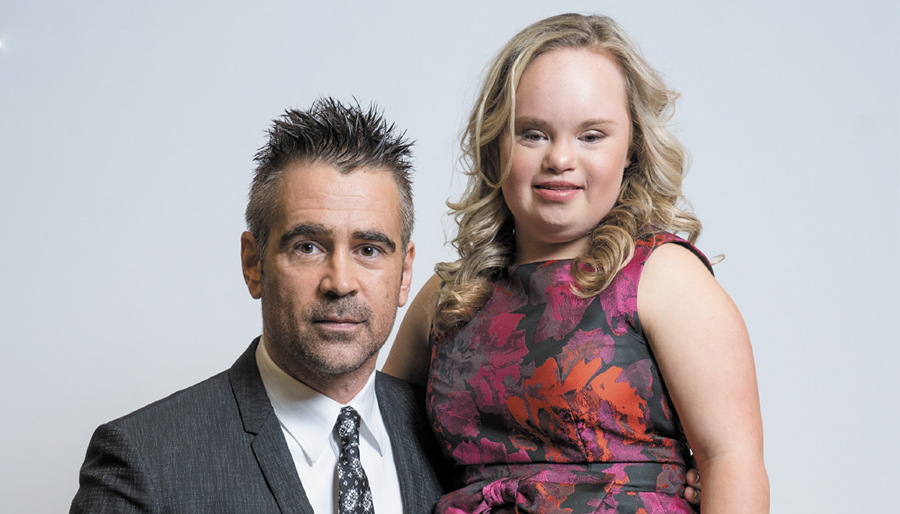
From Down Syndrome WorldTM 2019 Issue 3 of 4
Ensuring 2019 Global Ambassador Charlotte Fonfara-LaRose has a ball at the red carpet premiere of Dumbo
 This article was published in the award-winning Down Syndrome World™ magazine. Become a member to read all the articles and get future issues delivered to your door!
This article was published in the award-winning Down Syndrome World™ magazine. Become a member to read all the articles and get future issues delivered to your door! IN MARCH 2019,Charlotte Fonfara-LaRose attended the movie premiere of Tim Burton’s live-action remake of the Disney classic Dumbo as Colin Farrell’s guest. Farrell, who plays circus stalwart Holt Farrier in the film, says, “I was so happy to see Charlotte again at the premiere, and I hope to see her again soon!”
Charlotte assures us the feeling was mutual.
“I felt like a celebrity on the red carpet — he totally remembered who I was and gave me a hug!”
Other cast members in attendance included Michael Keaton, Danny DeVito, Eva Green, and Alan Arkin. As for hanging out with other celebrities on the red carpet like Helen Mirren, Charlotte exclaims, “It was so exciting!”
This amazing opportunity stemmed from Farrell’s generous live auction donation at the Global Down Syndrome Foundation’s 10th Anniversary Be Beautiful Be Yourself Fashion Show in 2018, where Charlotte was a model and Farrell was an awardee. This year, Charlotte has been chosen as the 2019 Global Ambassador where she and her family will be honored at Global’s marquee annual fundraiser.
MEET CHARLOTTE FONFARA-LAROSE
The 16-year-old firecracker was named after her maternal grandmother, Charlotte. Charlotte is a natural activist who loves to help people.
“I help anyone feeling sad feel better by giving them a hug,” she says.
Cathy Fonfara and Scott LaRose had Charlotte in 2003. The young new parents did not learn Charlotte would have Down syndrome until she was born, causing quite a shock. However, both Cathy and Scott come from large dedicated families, who rallied in support of their beautiful new addition to the family.
“Her birth made us want to be better people, and we wanted better for her,” says Cathy. “She is really the reason that we have such a great relationship and that we are a loving family together.”
Scott recalls that his father, who was an engineer and probably knew the least about Down syndrome in the whole group, came to them two days after Charlotte’s diagnosis with a binder of information.
“It was a very touching way to approach things, and I think it certainly helped us dig in a little bit,” Scott tells.
Sixteen years later, the family remains close. The Fonfara and LaRose families have a unique arrangement that works well for them and gives Charlotte lots of quality time with her large extended family.
“Scott and I are no longer a couple, but we are a family and we will always be a family,” says Cathy. “We vacation together, we go out to dinner as a family, and we spend every holiday together as a family.”
Charlotte lives full time with her mom and 8- year-old sister, Noelle, in Annapolis, Maryland. Scott is a ver y attentive father who is involved in every aspect of Charlotte’s life. Charlotte also has special relationships with both her grandmothers: Cathy’s mom, whom she calls “Oma,” and Scott’s mom, whom she calls “ Gigi.”
Charlotte is an inspiration to her family and a role model to her little sister, classmates, and peers. She doesn’t let Down syndrome get in the way of pursuing her dreams, and she lives her life as any typical 16-year-old. She loves horseback riding, swimming, paddleboarding, and traveling. In fact, she’s traveled to over 30 states and 10 countries with her family! She has a boyfriend named Zach, whom she has known since childhood, and they love going on sushi dates. Charlotte has dreams of owning a bagel shop one day, marrying Zach, and living in a blue and red home together.
Charlotte has inspired her mom into action.
“Over the years Charlotte has shown me that all she needs is what all children need: love, support, and encouragement,” says Cathy. “She also has helped me to educate doctors, teachers, and school administrators about the ability and potential of people with Down syndrome.”
GLOBAL’S 2019 AMBASSADOR
This year, Charlotte and her family are thrilled to be named an Ambassador family at the 2019 Be Beautiful Be Yourself Fashion Show. The event is the largest fundraiser for Down syndrome in the world. Over 1,400 self-advocates, families, Hollywood and sports celebrities, community philanthropists, and government leaders attend each year.
Charlotte and her family are no strangers the star-studded evening, though. Cathy and Charlotte were introduced to Global when Zach was in Global’s Washington, D.C. Gala in 2013. Charlotte and Zach danced on the runway together during a performance by Sheryl Crow!
“When we attended our first fashion show, we were astounded by the effort, quality, and attention that Global put into providing such a beautiful and festive event to showcase the beauty of individuals with Down syndrome,” says Cathy.
While she is always impressed by the famous and influential people who come out to support the show every year, Cathy is clear.
“The best part is when the models walk the runway, unintentionally stealing the spotlight from those celebrities escorting them,” she says. “The pride and joy on the models’ faces is indescribable and inspiration is palpable.”
Charlotte and her family have now attended seven Global fashion shows.
COLIN FARRELL’S SPONTANEOUS AND IMPROMPTU GENEROSITY
In 2018, at Global’s 10th Anniversary Be Beautiful Be Yourself Fashion Show, guests went wild for the 25 models with Down syndrome, including Charlotte. They were also brought to their feet by two inspiring recipients of Global’s Quincy Jones Exceptional Advocacy Award — Zack Gottsagen and Colin Farrell.
Farrell is an award-winning Irish actor and activist. He received his first Golden Globe for In Bruges and was nominated for multiple awards for his performance in The Lobster, starring opposite Rachel Weisz. More recently he has star red in the Harry Potter spin-off prequel, Fantastic Beasts and Where to Find Them, The Killing of a Sacred Deer with Nicole Kidman, Roman J. Israel Esq. with Denzel Washington, and the Disney live-action film Dumbo directed by Tim Burton.
Farrell uses his public platform to support organizations he is passionate about. He serves a celebrity partner for the United Nations’ World Food Programme, was an official spokesperson for the Special Olympics World Games in Shanghai, and supports nonprofits focused on the differently-abled community in tribute to his son, James.
As a father to a son with Angelman syndrome, Farrell has supported the Foundation for Angelman Syndrome Therapeutics for over a decade. He credits his son with making his life more meaningful and fulfilling.
“James’ very existence has changed so much about my life and how I preserve my own life selfishly being a caretaker and having the gift of being a protector and a provider for James, and as someone who loves him endlessly, someone who has watched his growth from infant to child to teenager now and approaching his young manhood,” he says. “James’ strength and bravery, his individuality and yet his commonality are things I’m constantly struck by.
“And, of course, as a result of his existence, it has afforded me the great gift of being involved in the lives of other families who care for a child who is differently-abled,” Farrell continues. “I’ve been touched by and allowed to be close to families who share the struggles of just being a par ent first and foremost but also the extra struggles that can arise from being a parent of a child who is differently-abled. James’ enrichment of my life is beyond measure.”
Indeed, James and his work benefiting the differently-abled brought Farrell to Denver last year to receive Global’s highest honor. During the fashion show’s live auction, Farrell jumped up on stage alongside Jamie Foxx, Jeremy Renner, Von Miller, and John C. McGinley and spontaneously offered a trip to Hollywood and tickets to the premiere of Dumbo. Impressed and moved by Farrell’s generosity, Charlotte and her mom decided to bid on the tickets, and they won!
At the fashion show, Farrell took photos with Charlotte and all the models with Down syndrome, and spoke to reporters on the red carpet.
“Seeing all of the members of the community walking down the runway and seeing how much they were empowered, and how the models and every single person in the audience was enraptured, seeing this as an indelible moment and celebration of their lives, and their brilliance as human beings and spirits both individually and as a community, was extraordinarily enriching and also emboldening to observe,” Farrell says.
“What a class act to not only support Global with his presence at the gala but to also offer an ex citing item to raise more money,” says Cathy. “And then be so down to earth and caring to make my sweet Charlotte feel so special.”
FIGHTING DISCRIMINATION AND OVERCOMING CHALLENGES — A REWARDING LIFE
Thousands of guests travel from all over the world to see Global’s iconic fashion show, where models with Down syndrome rock the runway with their celebrity escorts. The evening gives attendees an opportunity to learn, network, and support Global’s work. Through ticket and table purchases, model sponsorships, silent and live auction bids, and general donations, the proceeds from Global’s Be Beautiful Be Yourself Fashion Show benefit their affiliates’ important work in research and medical care.
“The underlying theme of the fashion show is actually human and civil rights, and our event gets to flip an old, negative paradigm on its head,” says Michelle Sie Whitten, President and CEO of Global. “From very active members of the Global community to people who are completely new to Down syndrome, everyone leaves feeling they are a part of something bigger than themselves.”
Charlotte’s family agrees.
“We’ve faced some heartbreaking discrimination in the education system, with teachers creating restrictive learning environments and blatantly excluding kids with special needs,” says Cathy. “One of the many great things that Global does is helping every individual with Down syndrome with education from academia to life skills. They work with parents and their children on their IEPs (individualized education programs), and they are now developing an education center at their new headquarters to focus on vocational training.”
Global aims to show the world that people of all abilities , like Charlotte and James, should have the opportunity to reach their full potential and live happy, rewarding lives.
“Educating our medical professionals and our community is important,” says Farrell. “Imagine you are told your child may never walk and then you see your child take his or her first steps a couple of weeks short of their fourth birthday like James did. The profundity and the emotional magnitude are overwhelming and must be shared with others to educate how y our child’s future is communicated. So there will be great challenges with your child like any child, but the rewards can be unimaginable and even more magnified.”
WORKING HARD TO CREATE HEALTHY LIVES
Global’s Ambassadors and models help raise awareness and advocate for people with Down syndrome to have equal access to transformative research, lifesaving medical care and other opportunities. And who’s at the top of Global ’s contact list for this? The U.S. government. Down syndrome has been one of the least-funded genetic conditions by the National Institutes of Health (NIH) for nearly 20 years, despite being the leading cause of developmental delay in the U.S. and the world.
Angelman syndrome is also a genetic condition. Farrell says that although he was saddened to learn about this disparity in funding, he wasn’t surprised.
“I think maybe the reason for this is a bittersweet one,” Farrell says. “Because people with Down syndrome are often presented as loving and happy, members outside of the community may think there’s no help needed. And it’s our job to teach others that people with Down syndrome need specialized medical care and research and, frankly, help throughout their lives and raise awareness.”
Farrell is optimistic about the progress in research for various genetic conditions “It’s an exciting time in science, and the future is looking brighter for our children than ever before.”
Over a decade of Global lobbying Congress and collaborating with the NIH has resulted in a tripling of the NIH’s Down syndrome research budget, from $27 million in 2016 to $77 million in 2019.
“Through Global, we have come to understand that people with Down syndrome have a different disease profile and that they need specialized medical care throughout their lives,” says Scott. “I was shocked to learn that there are no updated, evidence-based medical care guidelines for adults with Down syndrome. We are hugely grateful to Global and the experts who are working to create those for Charlotte and our community.”
“Global’s amazing work in advocacy, medical care, research, and government legislation will help my daughter and others with Down syndrome be able to live the lives they want and the lives all parents wish for their children,” says Cathy.
“Global’s work is so important because they help find the best treatments for people with Down syndrome who are sick,” Charlotte adds.
The connections between Down syndrome and cancer research are particularly important to the family. In 2016, Charlotte’s friend Mary Miller was diagnosed with leukemia. Charlotte and Mary, both born with Down syndrome, have been friends since appearing as models in Global’s 2014 Be Beautiful Be Yourself Fashion Show. Motivated by Mary’s fight against leukemia and their desire to fund critical Down syndrome research, Cathy and Scott funded a Basic Science Grant to Joaquín Espinosa, Ph.D., and his team at the Linda Crnic Institute for Down Syndrome at the University of Colorado Anschutz Medical Campus. Additionally, Charlotte’s grandmother Gigi has cancer, and as always, the family is supporting her every step of the way.
“Charlotte has a heart of gold and is already a champion for others who are sick or who she feels are disadvantaged in some way,” says Cathy. “She was just born that way, and we can’t wait to see what challenging projects and work she will take on going forward.”
“As a parent, Charlotte is my number one priority,” says Scott. “I want to make sure she receives everything she needs to reach her potential. By supporting Global, we have the luxury of not only helping Charlotte, but helping all people with Down syndrome and that’s an amazing feeling.”
Charlotte will be featured at Global’s Be Beautiful Be Yourself Fashion Show on Saturday, Nov. 2. Farrell encourages everyone to support her.
“I would recommend anyone who gets a chance to support Global and the Be Beautiful Be Yourself Fashion Show in Denver try and make the trip. Charlotte and everyone with Down syndrome deserve your attention. The event itself is love, community, harmony, unity, and unbridled hope for our future.”
“Whether she is being poked and prodded for medical tests, being underestimated by teachers at school, or having people staring at her as she walks down the street, Charlotte has always been brave, resolute, and true to herself. She is truly a great role model and Ambassador.”
Charlotte is excited to apply her strength and passion to her new role with Global.
“As Global’s Ambassador, I hope to help other people with Down syndrome be healthier through medical research, to bring attention to Global’s mission, and to bring respect to people with Down syndrome.”
Like this article? Join Global Down Syndrome Foundation’s Membership program today to receive 4 issues of the quarterly award-winning publication, plus access to 4 seasonal educational Webinar Series, and eligibility to apply for Global’s Employment and Educational Grants.
Register today at downsyndromeworld.org!
Understanding Behavioral Challenges
September 19th, 2019 by Global Down Syndrome Foundation
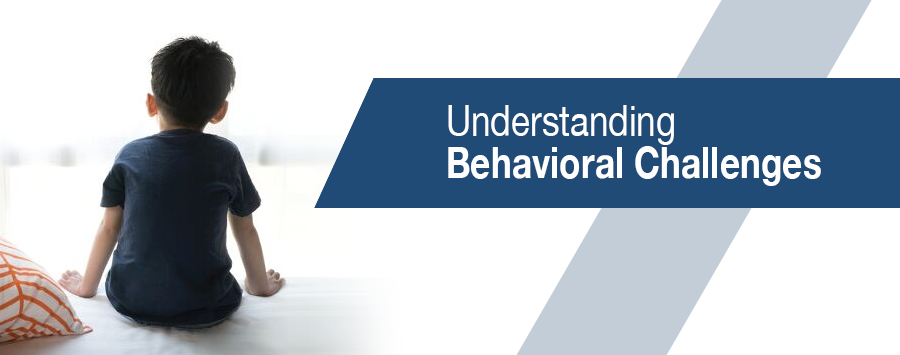
An important study in the journal of mental health research in intellectual disabilities shows that children with Down syndrome demonstrate increased behavioral issues compared with their typical peers. Early intervention and a development strategy can help.
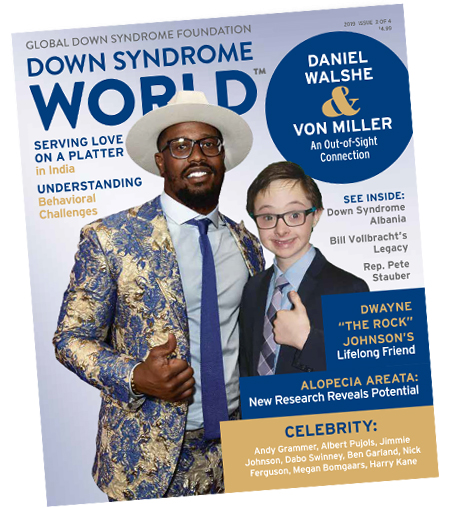 This article was published in the award-winning Down Syndrome World™ magazine. Become a member to read all the articles and get future issues delivered to your door!
This article was published in the award-winning Down Syndrome World™ magazine. Become a member to read all the articles and get future issues delivered to your door! A STUDY CONDUCTED by doctors at the Anna and John J. Sie Center for Down Syndrome at Children’s Hospital Colorado, an affiliate of the Global Down S yndrome Foundation, found that 94% of children with Down syndrome experienced one or more behavioral challenges on a w eekly or even daily basis. These behaviors include wandering off, refusal to follow instructions, aggression, impulsivity, and difficulty transitioning from activity to activity. Behavioral challenges can not only impact a child’ s quality of life but also cause major str esses for parents, teachers, and other caregivers.
In the study, Lina Patel, Psy.D., and her three co-authors, Kristine Wolter-Warmerdam, Noel Leifer, and Francis Hickey, M.D., analyzed current tools for measuring behavior in children with Down syndrome to determine which methods were effective and which could be improved upon. They also surveyed parents to learn about which behaviors were the most common and if any challenges shared a common denominator. The doctors published their results in late 2018.
Children with Down syndrome have many positive behavioral traits, and typical children certainly have negative behavioral issues. However, because of lack of research, behavior issues in children with Down syndrome are less understood. Behavioral challenges can hamper a child’s ability to function independently, perform well in school or other social settings, and even handle everyday tasks, such as bathing and dressing, at home. By understanding what can trigger certain behavioral issues, parents and teachers can better develop strategies to intervene before issues progress.
COMMUNICATION TOOLS: A COMMON DENOMINATOR
A variety of factors may fuel undesirable behaviors, according to Dr. Patel, lead author and D irector of Psychology at the Sie Center.
“I feel like motivation is a key factor,” Dr. Patel says. “It doesn’t mean that children with Down syndrome are unmotivated. It might just mean they are motivated by their own interests versus the task at hand, which then may result in behavioral challenges.”
Dr. Patel and her co-authors wanted to know which behaviors parents of children with Down syndrome found most concerning. They asked parents of 274 children seen at the Sie Center from 2010 to 2015 to fill out a specially designed questionnaire. On the questionnaire, parents were asked to state the frequency with which 16 behavior challenges occurred and their level of concern about each. Parents could also name additional behavioral challenges not listed on the form. The study is one of the largest of its kind and the results were not completely anticipated.
Noncompliance, wandering, sitting down and refusing to move, and aggression were the most common difficult behaviors parents reported. The amount and frequency of challenging behaviors was much higher than previously reported in scientific literature, with nearly 100% of parents noting the existence of challenging behaviors at least weekly.
“The most striking result we found was the frequency of behavioral challenges,” Dr. Patel says. “I think we did capture a wider array of behaviors, resulting in a higher percentage of children experiencing those behaviors. The good news is that many of the behavioral challenges that we assessed can be addressed using behavioral strategies that are informed by neurodevelopment.”
Neurodevelopment is the brain’s development of neurological pathways that influence areas including memory, intellectual functioning, attention, and focus.
The researchers also wanted to determine if any of these behavioral challenges shared a common denominator. They found that the inability of a child to effectively communicate his or her wants and needs was associated with many behavioral challenges.
“Behavior is a form of communication people use when they do not have access to other methods of communication, like verbal communication,” Dr. Patel explains. “Therefore, it’s not surprising that individuals with Down syndrome would have more behavioral challenges if they do not have more functional communication strategies.”
TAKE ACTION EARLY
The longer parents allow unwanted behaviors to persist, the more ingrained these behaviors may become.
“Behavioral interventions can make a difference and really change behavior,” says Elise Sannar, M.D., Assistant Professor of Child and Adolescent Psychiatry at Children’s Hospital Colorado. “If [parents] just live with [a behavior], it’s definitely not going to get better. If kids with Down syndrome learn that if they have a tantrum or refuse to move, they’ll get what they want, that will be reinforced, and they’ll continue to engage in that behavior.”
When concerning behaviors arise, parents should notify their child’s pediatrician or primary care physician as soon as possible so medical causes can be ruled out. Many behavior issues can be triggered by medical ailments to which children with Down syndrome are more predisposed. One such medical ailment is obstructive sleep apnea, which is found in up to 70% of children with Down syndrome.
In addition, parents should pay attention to the context of behavioral challenges — when, where, and with whom they occur, and what happens before and after them, says Anna Esbensen, Ph.D., Associate Professor, Research Director at the Jane and Richard Thomas Center for Down Syndrome in the Division of Developmental and Behavioral Pediatrics at Cincinnati Children’s Hospital Medical Center.
These clues can provide important information about why behaviors occur. Parents who are concerned about a behavior that happened when they weren’t around can ask their child’s friends, teacher, or employer for information about what took place.
“Teaching the child a replacement behavior or a different way of achieving or communicating their needs are helpful ways of teaching an adaptive … method of achieving their desired function,” Dr. Esbensen explains.
She continues, “Once we understand the function of the child’s behaviors, there are evidence-based strategies that can be used to modify that behavioral challenge.”
According to Dr. Sannar, one such strategy is applied behavior analysis (ABA), which uses a variety of techniques, such as positive reinforcement, to increase helpful behaviors and decrease damaging ones. ABA can be effective in children with Down syndrome, autism, and other conditions associated with behavioral challenges.
For example, Dr. Patel says, ABA can be used to stop a child with Down syndrome from running or wandering away from caregivers, also called elopement. A behavioral analyst can collect data to better understand why the child is eloping — is he or she bored, trying to avoid a difficult task that is hard, or eager for attention? Once the analyst has an answer, he or she can create a plan to address it. For example, if the child is avoiding work that feels too hard, the analyst can slowly increase a task’s difficulty or teach the child to ask for a break.
Helping people with Down syndrome manage behaviors is important, not only for their success in school and social situations but also as they enter adulthood, says Dr. Patel.
“Many individuals with Down syndrome who have the skill to seek employment may not be able to if they have behaviors that interfere with their job,” she advises. “It may be more difficult to gain independence with things like staying home alone or even living with others if these behaviors are not addressed.”
While it is more difficult to change longingrained behaviors, therapies and strategies exist that help adults, and studies are starting to address this older population.
The researchers plan to develop a more comprehensive tool to capture the full range of behavioral health challenges that children
with Down syndrome experience. They hope such a tool would help pediatricians and other community providers determine when to refer children to a behavioral health specialist. Most importantly, by understanding and analyzing. these behaviors, they hope to empower both individuals with Down syndrome and their parents to take necessary actions to improve and maintain appropriate behaviors.
Like this article? Join Global Down Syndrome Foundation’s Membership program today to receive 4 issues of the quarterly award-winning publication, plus access to 4 seasonal educational Webinar Series, and eligibility to apply for Global’s Employment and Educational Grants.
Register today at downsyndromeworld.org!
An Out-Of-Sight Connection
September 12th, 2019 by Global Down Syndrome Foundation
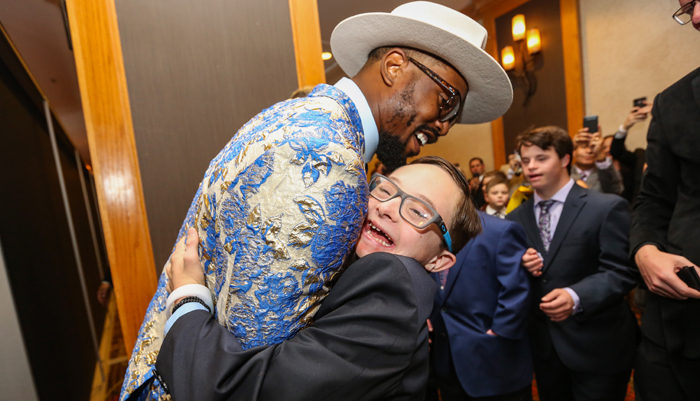
Last year, the Global Down Syndrome Foundation’s 10th Anniversary Be Beautiful Be Yourself Fashion Show brought together two very different football fans: Denver Broncos Lineback Von Miller and one of his biggest Admirers, sports-loving 14-year-old Daniel Walshe. The two connected over their love of the game – and fashionable eyewear.
 This article was published in the award-winning Down Syndrome World™ magazine. Become a member to read all the articles and get future issues delivered to your door!
This article was published in the award-winning Down Syndrome World™ magazine. Become a member to read all the articles and get future issues delivered to your door! FOR MODELS AND ATTENDEES ALIKE, Global’s annual Be Beautiful Be Yourself Fashion Show is an unforgettable, magical experience. For Global participant Daniel Walshe, the fashion show was a chance to meet one of his longtime heroes, Super Bowl 50 MVP Von Miller. In 2011, Von was drafted by the Broncos as the No. 2 overall draft pick from Texas A&M University. Since then, the seventime Pro Bowl linebacker has posted the most sacks in the NFL. Daniel, a Broncos superfan, owns a Von Miller jersey and even rocks thick black-rimmed glasses because they look like Von’s trademark frames. Von was standing in front of the ballroom entrance when Daniel saw him, and Von greeted him with a big bear hug.
“Von was nice and friendly!” Daniel remembers..
“Both of them looked like they were having such a good time,” says Elaine Walshe, Daniel’s mom. “In fact, Daniel was so excited that a couple weeks later, he convinced us to take him to his first Broncos game to see his new friend in action.”
“I heard great things about Global’s fashion show from some of my current and former teammates that participated, like Peyton Manning and Brandon McManus,” Von says. “I went in not really knowing what to expect but wanted to go and show support for the event. I left being totally impacted by the type of community surrounding Global and the things they do. It was definitely lifechanging for me.”
TACKLING ADVERSITY & CREATING CHANGE
Being the successful athlete and force of nature on the football field that he is, it’s difficult to imagine a guy like Von Miller feeling self-conscious. But when he was a skinny, glasses-wearing fifth grader in Texas, Von didn’t feel destined for a career in professional football. In fact, at first, he had to beg his father to allow him to join a youth football team at the time because his father didn ’t believe he was ready to play. When Von finally began playing, he remembers enduring taunts from other children about his sports glasses.
“I started wearing glasses in second grade,” Von tells. “At first, I’m not going to lie, it was horrible. It wasn’t cool. When I found out I had to wear glasses, I was sad and depressed about it, but over time, I just grew into them, and they became ‘me.’ That’s how I can relate with so many kids who have glasses.”
After establishing himself as a successful professional football player in the NFL, Von was able to turn his childhood insecurities and fears into a way of inspiring children and boosting their confidence.
In 2012, he established Von’s Vision, a philanthropic organization that provides free eye exams and glasses to low-income children in the Denver area. To date, the organization has raised $5.1 million and provided over 8,500 Denver students with free eye care services. Throughout the year, Von’s Vision also funds portable optical exam centers so children in the community can get the eye exams they need.
Von was awarded the 2017 Broncos’ Community Impact Award for his charitable influence. Every spring, the team rallies in support of Von and hosts Von’s Vision Day Celebration at Broncos Stadium at Mile High. Children from identified schools and community organizations are invited to receive free eye screenings and exams. Additionally, participants are given the chance to meet Von.
“There are so many wonderful things we’ve done with the organization,” Von says proudly. “When we created Von’s Vision, I was happy to help one or two kids. To help so many kids and raise so much money for glasses is amazing. I have a wonderful team behind me that has blessed me and allowed me to impact so many lives.”
Up to 50% of people with Down syndrome will need glasses. The most common vision problems include farsightedness, nearsightedness, strabismus (crossed eyes), and astigmatism (blurred vision). Daniel started wearing glasses in kindergarten to address his farsightedness and astigmatism.
Von’s philanthropy work with eyesight and vision issues are very important and relevant to the Down syndrome community, and he understands exactly why.
“For some people with Down syndrome, it’s not that they can’t read, they just can’t see,” Von says. “They have a hard time being able to see words on a paper. That’s my life right there. I’ve always had problems with vision. I know what it feels like to have corrective vision, and I know what type of impact that can have on your life.”
Daniel is a big admirer of Von’s distinctive eyewear.
“When we went shopping for a pair of glasses a couple of years ago, Daniel was thrilled to find a pair of iconic thick black-rimmed glasses that looked like ones he’d seen on Von,” Elaine says.
Thanks to role models like Von, Daniel lets nothing stand in his way. He has faced several health problems, including chronic sinus and thyroid issues and sleep apnea, to which individuals with Down syndrome are predisposed. Daniel has benefited from medical care at the Anna and John J. Sie Center for Down Syndrome at Children’s Hospital Colorado, a Global affiliate, and knows how to have an active and healthy lifestyle. Daniel continues to pursue activities he loves, including swimming on a local rec team and playing Ultimate Frisbee and basketball on his middle-school team.
ADVOCATES FOR GLOBAL
The Walshe family became part of the Global family in 2010. Daniel met the Global staff and many new friends through medical visits and various Global events and programs.
“Global has been a tremendous support to Daniel, both socially and medically,” says Elaine. “The amount of Down syndrome resources they provide and access to specialists is incredible.”
“When we had Daniel, we were piecemealing together what medical areas were important and which doctors we should go see, just within different moms’ groups,” Elaine continues.
She adds, “Now you can go to the Sie C enter, and they will assess y our child and say, ‘Go see this specialist and that ther apist, and here’s what you need to do.’ It’s a one-stop shop, and they schedule the appointments for us. It’s been a life-changer.”
With access to great health care, Daniel has been able to participate in a variety of
Global’s Dare to Play programs, improving on his skills in soccer, football, dance, tennis, and more.
“It’s been an opportunity to meet other kids who have Down syndrome who have similar
interests,” Elaine says. “Without those programs, he probably wouldn’t have met all the wonderful friends he has.”
Daniel was also a model in Global’s 2014 Be Beautiful Be Yourself Fashion Show,
and the family continues to at tend the event every year. At the 2018 Be Beautiful Be Yourself Fashion Show, Daniel got to witness one of his heroes, Von, escort Global Ambassador DeOndra Dixon, down the runway. With encouragement from Oscar-winner Jamie Foxx, Von even put his gold suit with a blue floral pattern up for live auction. To the audience’s delight, then-Broncos quarterback Case Keenum purchased the jacket. The funds will underwrite important research and medical care for people with Down syndrome.
LOOKING FORWARD TO WHAT’S NEXT
A successful soon-to-be eighth grader who loves football stats and U.S. presidential history, Daniel is already thinking about starting high school. His parents anticipate he will go to college, enter the workforce, and enjoy an independent adult life. And Daniel has an even bigger goal — he wants to become a police officer.
“People with Down syndrome can do pretty much what they have the opportunity to do,” Elaine says.
As for Von, he is full of optimism as he prepares for his ninth NFL season
with the Broncos and a new head coach. He may be focused on the future, but he still reflects fondly on the Be Beautiful Be Yourself Fashion Show, where his life became a little richer.
“There is just so much love [from people with Down syndrome],” Von says. “I gave so many hugs that night. I walk into our facility every day with my teammates, and don’t even hug those guys, but every single person [at the fashion show] gave so much love. It was amazing.”
Like this article? Join Global Down Syndrome Foundation’s Membership program today to receive 4 issues of the quarterly award-winning publication, plus access to 4 seasonal educational Webinar Series, and eligibility to apply for Global’s Employment and Educational Grants.
Register today at downsyndromeworld.org!
Navigating a Dual Diagnosis of Down Syndrome and Autism
September 4th, 2019 by Global Down Syndrome Foundation
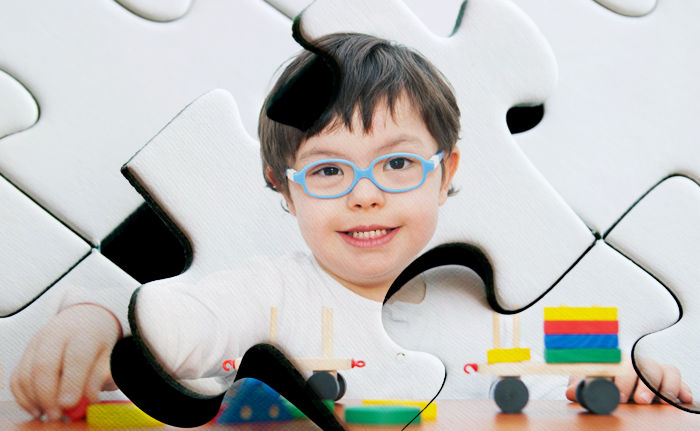
Finding out your child with Down syndrome has co-occurring Autism Spectrum Disorder (DS-ASD) can be daunting, but a better understanding of DS-ASD opens doors to resources and support that benefit children and families alike.
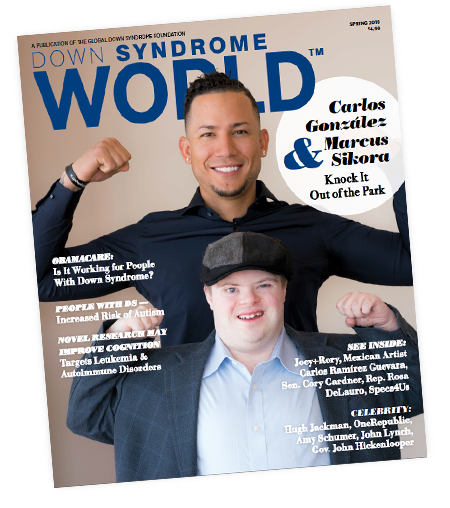 This article was published in the award-winning Down Syndrome World™ magazine. Become a member to read all the articles and get future issues delivered to your door!
This article was published in the award-winning Down Syndrome World™ magazine. Become a member to read all the articles and get future issues delivered to your door! ACCORDING TO THE American Psychiatric Association, ASD is a complex developmental disorder that can cause problems with thinking, feeling, language, and the ability to relate to others. Symptoms occur on a spectrum ranging from mild to severe, and are characterized by challenges in social interaction, verbal and nonverbal communication, and repetitive behaviors.
Current research suggests between 8 and 18 percent of individuals with Down syndrome may also have autism. According to Sarah Hartway, R.N., M.S., President of the Board of Directors of The Down Syndrome-Autism Connection™, an additional 25 percent of people with Down syndrome may exhibit some autism symptoms but not with enough prevalence or severity to be diagnosed with DS-ASD.
“We know autism occurs more frequently in people who have other genetic or chromosomal anomalies,” Hartway said. “So it’s not surprising that people who have Down syndrome are more likely to have autism than the general population.”
SPOTTING THE SIGNS OF AUSTISM
“All children, at any given time, can exhibit behaviors that are consistent with autism, but a child with DS -ASD may engage in them more frequently or find them to be more problematic,” said Robin Zaborek, who also sits on The Down Syndrome-Autism Connection Board of Directors. “Number, frequency, and intensity of behaviors may be distinguishing factors in evaluating for DS-ASD.”
According to Zaborek, children with DS-ASD may engage in the following behaviors:
- Unusual vocalizations
- Repetitive motions, such as rocking or clapping
- Persistent, pronounced need for structure and routine
- Disinterest in playing with others
- Inappropriate laughing or crying
- Repetitive playing with an object, such as a wooden spoon
In some cases, children with DS-ASD may engage in dangerous behavior, such as running away, self-injury, or aggression. They may struggle to reach developmental milestones and have problems with eating, sleeping, and toilet training. They’re also more likely to have certain medical and behavioral conditions, including gastrointestinal issues, seizures, anxiety, and attention-deficit/hyperactivity disorder.
Fortunately, there are resources and ongoing research for people with ASD that will also benefit people with the dual diagnosis. But diagnosing DS-ASD can be a challenge. “Not all medical professionals are aware Down syndrome and autism can co-occur,”
“Not all medical professionals are aware Down syndrome and autism can co-occur,” said Margaret Froehlke, R.N., B.S.N., Secretary of the Board of Directors at The Down Syndrome-Autism Connection. “If families have a Down syndrome clinic in their community, the clinicians there would be better able to make a dual diagnosis because they have the appropriate background.”
Examples of such clinics include the Anna and John J. Sie Center for Down Syndrome at Children’s Hospital Colorado and the Thomas Center for Down Syndrome Services at the Cincinnati Children’s Hospital Medical Center.
Beyond such specialty Down syndrome clinics, Froehlke recommends parents visit a facility that belongs to the network of University Centers for Excellence in Developmental Disabilities, listed at aucd.org.
THE BENEFIT OF KNOWING
Parents of children with undiagnosed DS-ASD can feel very isolated, Froehlke said. They may look at how their child interacts with his or her peers with Down syndrome, and when their child isn’t developing in the same ways or at the same pace, they may pull away from their friends in the Down syndrome community.
“For me and many other parents, getting a dual diagnosis actually leads to relief and validation, because now you understand why your child is different,” she said. “You can begin to seek out the treatments, support, and interventions available to you.”
“There is a compassionate community of professionals and families out there who truly understand the DS-ASD journey is different,” Hartway added. “No one has to walk this path alone.”
Like this article? Join Global Down Syndrome Foundation’s Membership program today to receive 4 issues of the quarterly award-winning publication, plus access to 4 seasonal educational Webinar Series, and eligibility to apply for Global’s Employment and Educational Grants.
Register today at downsyndromeworld.org!
Discrimination and Down syndrome
August 21st, 2019 by Global Down Syndrome Foundation
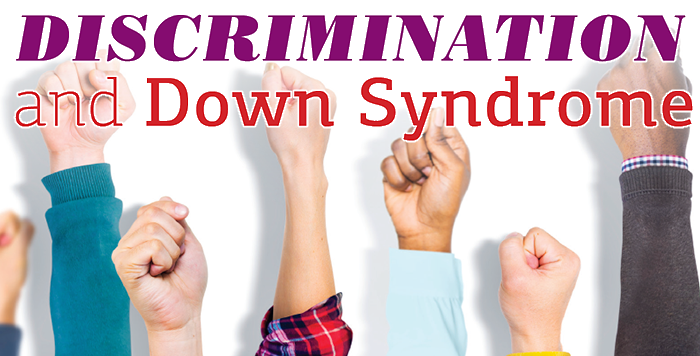
Instances of discrimination in England, Australia, and Thailand have sparked international outrage among citizens who have Down syndrome, their families, and society at large. They also force us to acknowledge the need for education.
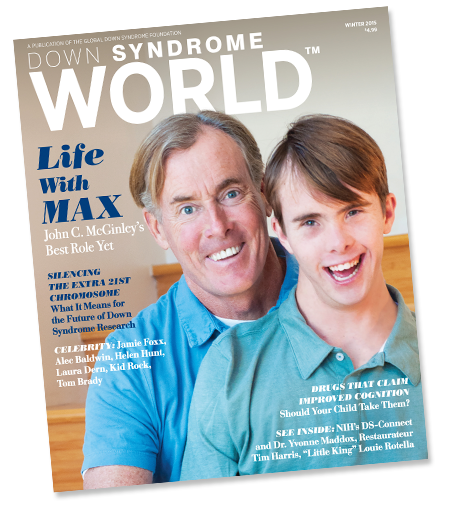 This article was published in the award-winning Down Syndrome World™ magazine. Become a member to read all the articles and get future issues delivered to your door!
This article was published in the award-winning Down Syndrome World™ magazine. Become a member to read all the articles and get future issues delivered to your door! IT’S IMPOSSIBLE TO know what kind of response @InYourFaceNYer expected when she tweeted former Oxford professor, evolutionary biologist and famed atheist writer Richard Dawkins an ethical dilemma: What should she do if she were pregnant with a child with Down syndrome? But even those familiar with Dawkins’ beliefs were shocked at his response: “Abort it and try again. It would be immoral to bring it into the world if you have the choice.”
Dawkins’ comments came on the heels of another headline grabber covered by CNN, Fox News, the BBC and other major media outlets — in August 2014 an Australian couple, who hired a Thai surrogate mother to carry their biological child (which became twins) via in vitro fertilization, left one of the twin infants, Gammy, with the surrogate after learning the child had Down syndrome.
Both incidents illustrate that acceptance and equality for those with Down syndrome and other disabilities is still very much at stake.
“Discrimination against people with Down syndrome, even in developed nations, is profound,” said Michelle Sie Whitten, Executive Director of Global Down Syndrome Foundation. “The reality is that the condition is almost completely different from what it was just 20 years ago. For example, the lifespan of a person with Down syndrome in the 1980s was 28 years old, and today it is nearly 60.”
SIGNIFICANT IMPROVEMENT BUT A LONG WAY TO GO
In the United States, recently retired Iowa Sen. Tom Harkin authored and sponsored the Americans with Disabilities Act. The ADA is a wide-ranging civil rights law prohibiting discrimination based on disability. Essentially, it expanded on the great work of activists who passed the Civil Rights Act of 1964, which made it illegal to discriminate based on race, religion, sex, and national origin.
Despite passage of the ADA, people with intellectual disabilities face an uphill battle. In 2012, the People with Disabilities Foundation won a lawsuit against the Social Security Administration for terminating benefits for people with intellectual disabilities without communicating the complexities of agency requirements in a manner that people with intellectual disabilities could understand.
There are also discrimination and prejudices that can be seen from various surveys. In an essay published in the book Prenatal Testing and Disability Rights, ethicist and sociologist Dorothy Wertz, Ph.D., cites surveys she’s conducted in which 13 percent of genetics professionals say they actively emphasize negative aspects of having a child with Down syndrome and 10 percent actively encourage termination. In another 2006 study by the American Congress of Obstetricians and Gynecologists, over 40 percent of professionals rated their training in delivery of prenatal diagnoses as “barely adequate” or “nonexistent.”
“People with Down syndrome have been subject to exclusion from society and from discrimination across the board — in educational settings, employment, and in their communities,” said David Tolleson, Executive Director of the National Down Syndrome Congress. “Much of it is due to a lack of understanding and education and exposure to people with Down syndrome.”
MAINSTREAM U.S. SHOWS TRENDING SUPPORT
It appears educating professionals and the government should be a top priority for advocacy groups. Mainstream Americans, however, overwhelmingly embrace the idea that people who are “disabled” or differently-abled are different but equal.
According to a nationwide poll, more than 75 percent of Americans believe people with Down syndrome have the right to vote, buy a home, and get married. Ninety-six percent believe children with Down syndrome should have a right to attend their local public schools and 75 percent believe it not only benefits the child with Down syndrome but also the typical child in the classroom. An impressive 97 percent of Americans agree that people with Down syndrome should have the chance to hold a job and deserve fundamental human and civil rights.
There is no lack of illustrious counterweights to both the Dawkins incident and the baby Gammy incident. Marilyn Coors, Ph.D., Professor of Bioethics and Genetics at the University of Colorado Denver, weighed in: “I would like to ask Professor Dawkins if he has ever spent time with a child or adult with Down syndrome. Has he experienced their continual joy and happiness to be alive? Does he understand the beauty they bring to the world? His comment reveals his lack of knowledge of the lived experiences of those with Down syndrome and their families.”
A survey published in the American Journal of Medical Genetics shows that around 99 percent of people with Down syndrome indicate they are happy with their lives and love their families. The vast majority of surveyed parents of children with Down syndrome report having a more positive outlook on life because of their child, and nearly 90 percent of siblings feel they are better people because of their sibling with Down syndrome.
HOPE FOR THE FUTURE
In Gammy’s case, the good clearly outweighs the bad, as the surrogate mother agreed to raise the child herself. A fundraising campaign to help support the surrogate mom and pay for Gammy’s medical expenses drew upwards of 6,000 donations from around the world. More than $240,000 was raised for the child in four months.
Down syndrome advocacy groups were able to use the opportunity to educate a much wider audience through national press and get basic facts into the hands of many people outside the Down syndrome community.
Like this article? Join Global Down Syndrome Foundation’s Membership program today to receive 4 issues of the quarterly award-winning publication, plus access to 4 seasonal educational Webinar Series, and eligibility to apply for Global’s Employment and Educational Grants.
Register today at downsyndromeworld.org!

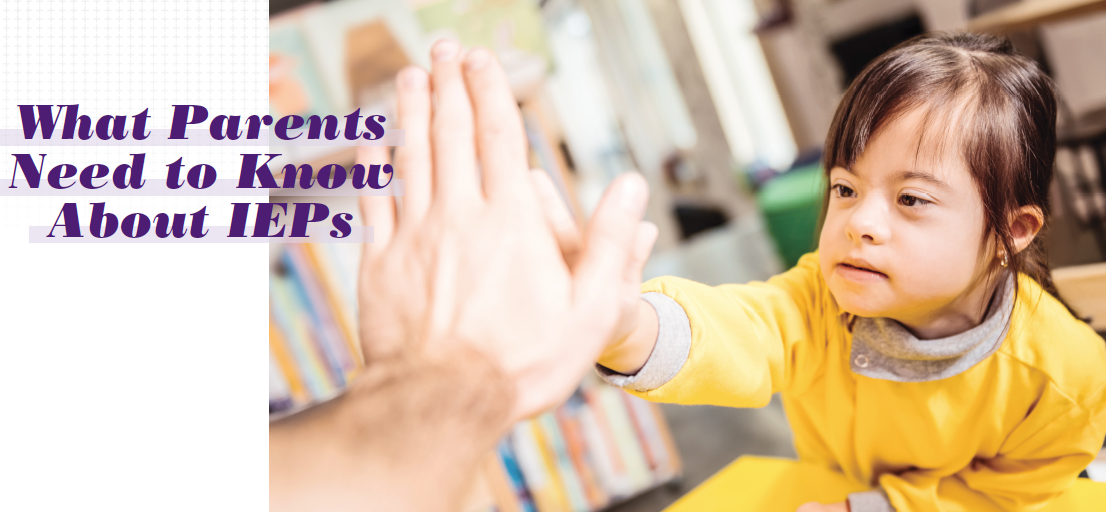
 Experience our inspirational and groundbreaking videos and photos. Our children and self-advocates are beautiful AND brilliant!
Experience our inspirational and groundbreaking videos and photos. Our children and self-advocates are beautiful AND brilliant! Make sure your local Representatives are on the Congressional Down Syndrome Task Force.
Make sure your local Representatives are on the Congressional Down Syndrome Task Force.